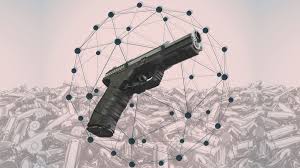
(from rand.org)
[Ed: We’re glad to introduce a new contributor, ‘MarkPA’, who combines 2A commitment, shooting expertise and analytic skills.]
Humans are injured and die from gun-shot wounds; and so, doctors lay claim to gun-control as a “public-health” issue. If this were “true” then it would follow that warfare is likewise a public-health issue about which doctors–and epidemiologists–have special expertise to contribute. Here at DRGO, we reject this assumption.
Biological scientists of all stripes are as free as any other professionals to comment on public safety issues. Yet, their training and expertise have little to do with the substantive issues in play with guns (or warfare, for that matter).
When the only tool you have is a hammer, the whole world looks like a nail. When your tool is epidemiology, you see the whole world as filled with pathogens and the vectors that disseminate them. This worldview is nonsense applied to guns.
A pathogen is a germ or virus that can produce a disease such as smallpox. Or perhaps an inorganic substance such as tetra-ethyl lead that was once used as a gasoline additive. Epidemiologists speak of transmission of a pathogen via a “vector”, such as the mosquito in the case of malaria.
The holy grail of pathogen control is eradication of the very last instance of the pathogen, such as was accomplished with smallpox at the end of the 1970s. The alternative can be control of all vectors, such as was accomplished with malaria through mosquito control in the US by the mid-20th century.
Epidemiologists think gun violence can be prevented by eliminating guns or, more realistically, reduced by restricting gun sales. In their double-speak, that means any firearms transfer from one possessor to another including loans for hunting or target practice. But epidemiology concepts of pathogens and vectors don’t apply to artifacts such as guns.
Gun-rights advocates note that guns are inanimate objects “that don’t pull their own triggers”. While this is true, and makes for a cute sound-bite, the observation does not fully explain why how misguided epidemiologists are.
A firearm is not a pathogen in any way analogous to the smallpox virus or an inorganic molecule such as lead. Every nation, and every government, concurred with the goal of smallpox eradication. Likewise, every society advanced enough to consume gasoline understands that “ethyl” contributes to lead poisoning in the atmosphere, harming the health of children in urban areas.
In contrast, every government arms its military and police—even the Holy See maintains guns in its armory. Most societies indulge some guns in the civilian sector for security, pest-control, hunting or recreation. Even the Japanese are recruiting female hunters (once a taboo) to hunt deer and wild boar. Unlike smallpox, governments and societies hold a consensus that guns will continue to serve legitimate purposes. As such, eliminating gun manufacturing and distribution is impossible. Gun eradication is out-of-the-question.
That leaves us with the possibility of vector control, i.e., limiting gun-trade/transfer and ultimately, controlling gun-possession. Remember, firearms can be made in factories or by individual craftsmen, now including the relatively unskilled using 3D printers or CNC mills at home.
Borders are porous. As Americans are keenly aware, Immigration and Customs Enforcement is overwhelmed by cross-border trafficking of drugs and humans. There is no control possible in movement across state lines or in shipments from U.S. off-shore territories like the Virgin Islands or Puerto Rico. So anyone can move firearms across the United States’ international borders and across the fifty states’ lines.
Quite unlike a pathogen such as smallpox or lead, there is no national consensus about possessing and trading guns in America. For that matter, there is no national consensus about illicit drugs or illegal immigration. Moreover, distinctions can be made among immigration, drugs and guns.
Constitutionally, the Federal government has power to regulate, even to forbid, immigration. Congress’s power to regulate drugs is the subject of serious debate. But based on the Heller and McDonald Supreme Court decisions, it is clear that both Congress and the States’ legislatures “shall not . . . infringe” on the “right to keep and bear arms” and that handguns, shotguns and rifles are indisputably protected.
America’s culture is not shame-based. Shame has not deterred illegal drug use or employing illegal aliens. Shame will not dissuade nearly half of America’s families to abandon their constitutional right to arms. Americans are not going to surrender as many as 350 million guns, some of which are family heirlooms.
America’s governments are limited in their constitutional powers, as well as in their practical abilities, to control cottage manufacture, trade, transfer, and possession of guns. The black-market for guns is no more controllable than is the black market for drugs. Likewise, the cottage industry in guns is no more controllable than it is for drugs. Possession in the home is impossible to control to any significant degree.
Examining just one source, American gun shops sell approximately 2 million guns per month. The last time when sales were below 1 million per month was 10 years ago. How many of these sales were “straw purchases” on behalf of prohibited persons? We have no clue. There is no shortage of adults with clean backgrounds willing to “lie for the other guy”. The Feds punish only a dozen per year.
Criminals and mass-killers are among the most motivated of acquirers. The quest for these objects of their desire will not be impeded by even the most vigorous enforcement regimes.
The best opportunity to minimize misuse of firearms–if any exists at all–is to intervene on unlawful possession by individuals who are likely to be dangerous to themselves or others. We have laws forbidding possession by minors, those adjudicated as incompetent or committed to mental treatment, and felons.
Society can choose to enforce these laws more or less vigorously. Ironically, present policy is to be lenient on felons in possession. When a gun is confiscated, too frequently no charges are filed. Often, illegal possession is plea-bargained away for a guilty plea on a related charge.
Under these circumstances, it is abundantly clear that epidemiology’s concepts of controlling “pathogens” or “vectors” are inapplicable to “gun control”. Guns are not “pathogens”. Lawful commerce in firearms precludes total “vector control”.
If the skills of the epidemiologist are to be applied at all, they should address public hygiene in mental illness generally. Mental illness is clearly associated with suicide, and there is evidence linking mental illness to some mass shootings and (rarely) other violent crime.
The proper subject of the epidemiologist is only the shooter, not the gun.
 —Life-long gun owner, NRA Instructor, Massad Ayoob graduate and financial analyst ‘MarkPA’ is inspired by our inalienable rights to “life, liberty and the pursuit of happiness”. He holds that having the means to defend oneself and one’s community are vital to securing them.
—Life-long gun owner, NRA Instructor, Massad Ayoob graduate and financial analyst ‘MarkPA’ is inspired by our inalienable rights to “life, liberty and the pursuit of happiness”. He holds that having the means to defend oneself and one’s community are vital to securing them.
